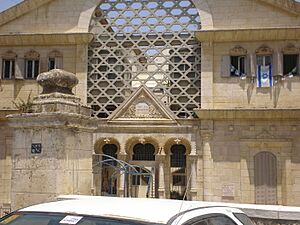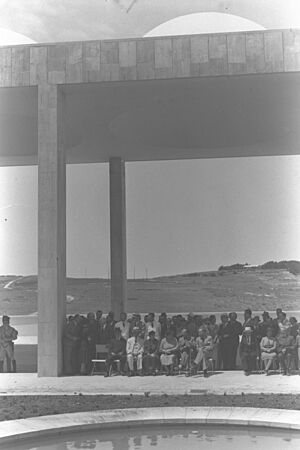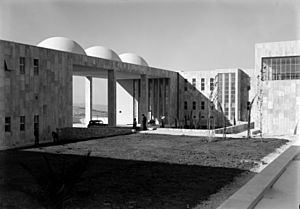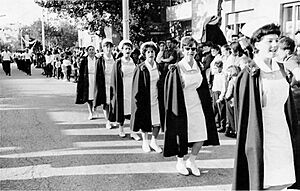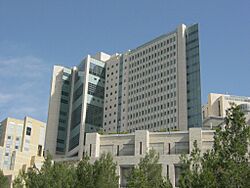Hadassah Medical Center facts for kids
Quick facts for kids Hadassah Medical Center |
|
|---|---|
 |
|
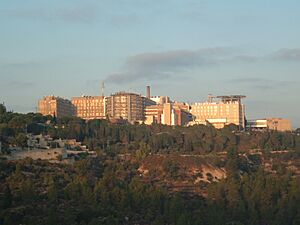
|
|
| Geography | |
| Location | Ein Karem, Jerusalem |
| Organisation | |
| Care system | Private |
| Hospital type | Teaching, District General |
| Affiliated university | Hebrew University of Jerusalem |
| Patron | Hadassah Women's Zionist Organization of America |
| Services | |
| Emergency department | Yes |
| Beds | 1,044 |
| History | |
| Founded | 1934 |
The Hadassah Medical Center is a well-known medical organization in Israel. It was started in 1934. Hadassah runs two big hospitals in Jerusalem. One is in Ein Karem and the other is in Mount Scopus.
Hadassah also has schools for medicine, dentistry, nursing, and pharmacy. These schools work with the Hebrew University of Jerusalem. Hadassah's main goal is to help everyone. They care for people no matter their background or beliefs.
The hospital was founded by the Hadassah Women's Zionist Organization of America. This group still helps pay for a lot of the hospital's costs today. Hadassah Medical Center is one of the largest hospital complexes in Israel. Across its two locations, it has over 1,300 beds. It also has many operating rooms and special intensive care units.
Contents
History of Hadassah
Early Years (1912–1915)
The Hadassah organization began in 1912 in New York City. Its first goal was to provide healthcare in Jerusalem. In 1913, Hadassah sent two nurses to the area. They opened a small health center in Jerusalem. This center helped mothers and treated eye diseases. During the First World War, the Hadassah Nurses station had to close.
Helping People in Palestine (1918–1948)
In 1918, Hadassah created the American Zionist Medical Unit (AZMU). This group had 45 medical experts. The AZMU helped set up six hospitals in Palestine. Hadassah also started a nursing school that year. This school trained local people to become nurses.
In 1919, Hadassah began checking the health of Jerusalem schoolchildren. During a time of unrest in 1920, Hadassah nurses cared for all injured people. Henrietta Szold moved to Jerusalem to help with health programs.
In 1921, Hadassah opened the first center for new mothers and babies in Jerusalem. They also opened hospitals in Tel Aviv and Haifa. In 1926, Hadassah started a center for treating tuberculosis in Safed. A new health center opened in Jerusalem in 1929.
Planning for a new main hospital began in the 1930s. The Rothschild-Hadassah University Hospital opened on May 9, 1939. It was the first teaching hospital in Palestine.
Hadassah also ran a clinic in Hebron. This clinic offered free care to everyone. A British report in 1937 praised Hadassah's work. It noted that Hadassah's services helped all communities.
The Hadassah Hospital on Mount Scopus opened in 1939. It had to close in 1948 due to conflict.
Changes After 1948
After the 1948 war, Mount Scopus became a special area. The Hadassah Hospital there could not operate. So, the medical staff moved to other places in West Jerusalem. In 1961, a new large medical center was built in Ein Karem. This was on the edge of Jerusalem.
During the Six-Day War in 1967, Israel gained control of the Mount Scopus area. The old medical campus was then reopened. Today, both campuses are active. The Ein Karem location is much larger.
Recent Years (Since 2005)
In 2005, Hadassah was nominated for the Nobel Peace Prize. This was because it treated all patients equally. It also worked to build peace between different groups.
French singer David Serero performed concerts at the hospital. He sang for Israeli and Palestinian children in 2011, 2012, and 2013.
In 2018, Hadassah Medical Center started a new branch in Skolkovo, Russia. This project aimed to bring Hadassah's medical care to more people. A part of the money earned there goes to cancer research.
Mount Scopus Campus
The first stone for the Hadassah hospital on Mount Scopus was placed in 1934. The building was designed by architect Erich Mendelsohn. It opened in 1939.
In 1948, a sad event happened. A group of doctors, nurses, and staff were attacked on their way to the hospital. Because of this, and the war, the hospital had to close.
After the Six-Day War, Hadassah Mount Scopus was fixed up. It reopened in 1975. This hospital has over 300 beds. It has many departments, including a rehabilitation center. It helps all people in Jerusalem. More than one-third of its patients are Arab.
In 2011, actress Natalie Portman helped raise money for the hospital. She was born at Hadassah Mount Scopus. Dr. Tamar Elram leads Hadassah Mount-Scopus today.
Ein Karem Campus
From 1948 to 1962, Hadassah hospital worked from different rented places in Jerusalem. In 1961, a new medical complex was built in Ein Karem. The Hadassah Women's Zionist Organization of America helped with money again. This location was chosen because it was hard to find a good spot in the city center.
The hospital was designed by Joseph Neufeld. Before a new tower opened in 2012, Hadassah Ein Karem had 700 beds. The hospital has 22 buildings. These include the Hebrew University of Jerusalem schools for medicine, dentistry, and nursing.
Since February 27, 2025, the Red Line of the Jerusalem Light Rail serves the campus. It has two stations there.
Professor Yoram G. Weiss is the director of Hadassah. Famous doctors there include Avraham Rivkind, who leads the trauma center. Ahmed Eid heads the organ transplant unit.
In 2007, a generous person named William Davidson donated $75 million to the hospital. In 2012, the Sarah Wetsman Davidson Hospital Tower opened. It has 500 beds and 20 operating rooms.
In 2009, the hospital opened a special fertility clinic for AIDS patients. This was the first clinic of its kind in Israel.
Chagall Windows
The synagogue at the Ein Karem campus has beautiful stained glass windows. They were made by artist Marc Chagall. The windows show the twelve tribes of Israel. Chagall wanted the synagogue to be like "a crown offered to the Jewish Queen." He called the windows "jewels of translucent fire." The windows were put in place in February 1962.
New Entrance and Gardens
In 2012, a new glass entrance building opened at the Davidson Tower. It helps guide all visitors into the hospital. Next to the building are four "healing gardens." These gardens were designed by Shlomo Aronson. They are based on the idea that nature helps people feel better.
Bio-park
Below the medical center is the Jerusalem Bio Park (JBP). This park is home to several biotechnology companies. One of them is Hadasit, which helps bring new medical ideas from Hadassah to the public.
Notable People from Hadassah
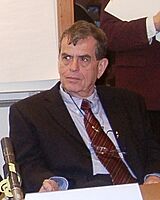
Many important people have studied or worked at Hadassah. Some of them include:
- Aaron Ciechanover (born 1947), a biologist and Nobel Prize winner in Chemistry.
- Avram Hershko (born 1937), a biochemist and Nobel Prize winner in Chemistry.
- Natalie Portman (born 1981), a famous Israeli-American actress, was born at Hadassah Mount Scopus.
Branches
-
Hadassah Medical Center in Skolkovo, Moscow.
See also
 In Spanish: Centro Médico Hadassah para niños
In Spanish: Centro Médico Hadassah para niños
- Health care in Israel
- List of hospitals in Israel
- Hadassah, the Women's Zionist Organization of America



